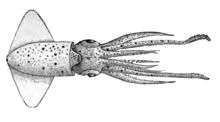Ancistrocheirus
Ancistrocheirus lesueurii, the sharpear enope squid, is the only species in the genus Ancistrocheirus and family Ancistrocheiridae. With a mantle length of 25 cm, this moderately sized squid may be found throughout the tropical and subtropical oceans. They tend to be found at mesopelagic depths (200–1000 m down).
| Sharpear enope squid | |
|---|---|
 | |
| Scientific classification | |
| Kingdom: | Animalia |
| Phylum: | Mollusca |
| Class: | Cephalopoda |
| Order: | Oegopsida |
| Family: | Ancistrocheiridae Pfeffer, 1912 |
| Genus: | Ancistrocheirus Gray, 1849 |
| Species: | A. lesueurii |
| Binomial name | |
| Ancistrocheirus lesueurii | |
| Synonyms[2] | |
| |
Although only one species is recognized, some have suggested more than one species may exist due to differences in the paralarval morphology. Paralarva is the first free-living stage for cephalopods.
Characteristics
The buccal crown of the sharpear enope squid is heavily pigmented. The squid has no vesicles. There are hooks on all its arms. The suckers are absent from its manus and the squid's dactylus is reduced.
Photophores
Photophores occur throughout its body. Large photophores are present on its head, funnel, base of arms, and tentacular stalk. Other photophores are present on the ventral surface of its mantle (usually 22), with numerous very small photophores on its head, funnel, base of arms II and tentacular stalk. Mature males have large photophores on tips of arms IV opposite the mouth. Mature females have photophores on tips of their dorsal six arms. The number of large photopores on the squid's mantle increases as it matures.
Ecology
They are eaten by the sperm whale in Southeast Asia and Galapagos waters[3][4]
References
- Allcock, L. & Barratt, I. (2014). "Ancistrocheirus lesueuri". IUCN Red List of Threatened Species. 2014: e.T163050A966613. doi:10.2305/IUCN.UK.2014-1.RLTS.T163050A966613.en.
- Julian Finn (2016). "Ancistrocheirus lesueurii (d'Orbigny [in Férussac & d'Orbigny], 1842)". World Register of Marine Species. Flanders Marine Institute. Retrieved 24 February 2018.
- Chua, Marcus A.H.; Lane, David J.W.; Ooi, Seng Keat; Tay, Serene H.X.; Kubodera, Tsunemi (5 April 2019). "Diet and mitochondrial DNA haplotype of a sperm whale (Physeter macrocephalus) found dead off Jurong Island, Singapore". PeerJ. 7: e6705. doi:10.7717/peerj.6705. PMC 6452849. PMID 30984481.
- Smith, Sean C.; Whitehead, Hal (April 2000). "The diet of Galapagos sperm whales Physeter macrocephalus as indicated by fecal sample analysis". Marine Mammal Science. 16 (2): 315–325. doi:10.1111/j.1748-7692.2000.tb00927.x.
- "CephBase: Ancistrocheirus". Archived from the original on 2005.
- Tree of Life web project: Ancistrocheirus lesueurii
- ITIS entry
